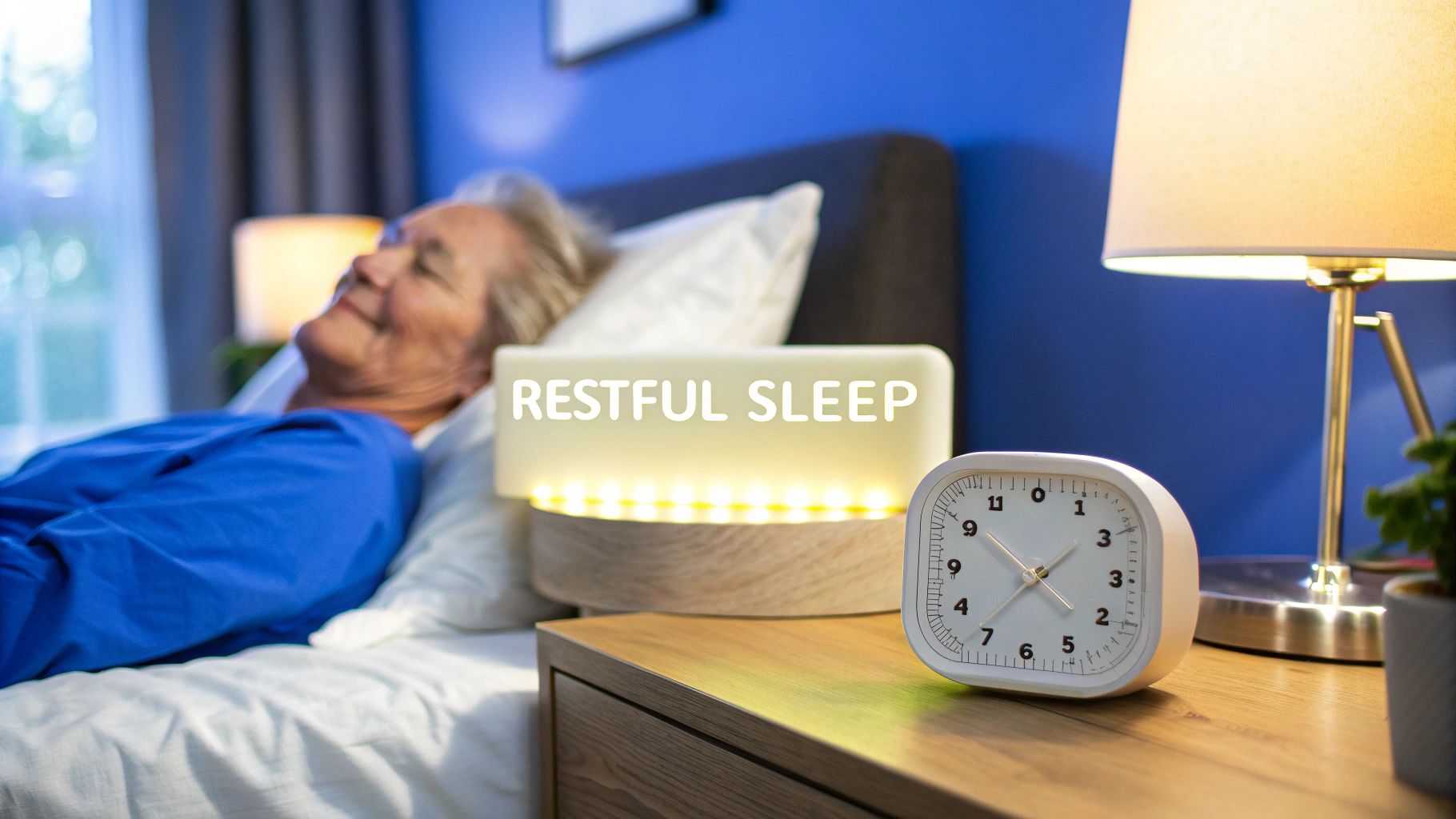For so many older adults, a "good night's sleep" starts to feel like a distant memory. The reality is often hours of tossing and turning, staring at the ceiling at 3 AM, or waking up long before the sun rises.
This struggle isn't just about feeling tired. It's a persistent, frustrating cycle of not being able to fall asleep, stay asleep, or waking up feeling completely unrested. Too often, this is dismissed as just another unavoidable part of getting older, but that overlooks a critical truth: while sleep patterns do change as we age, chronic insomnia is a distinct and treatable medical issue.
Why Restful Sleep Fades with Age
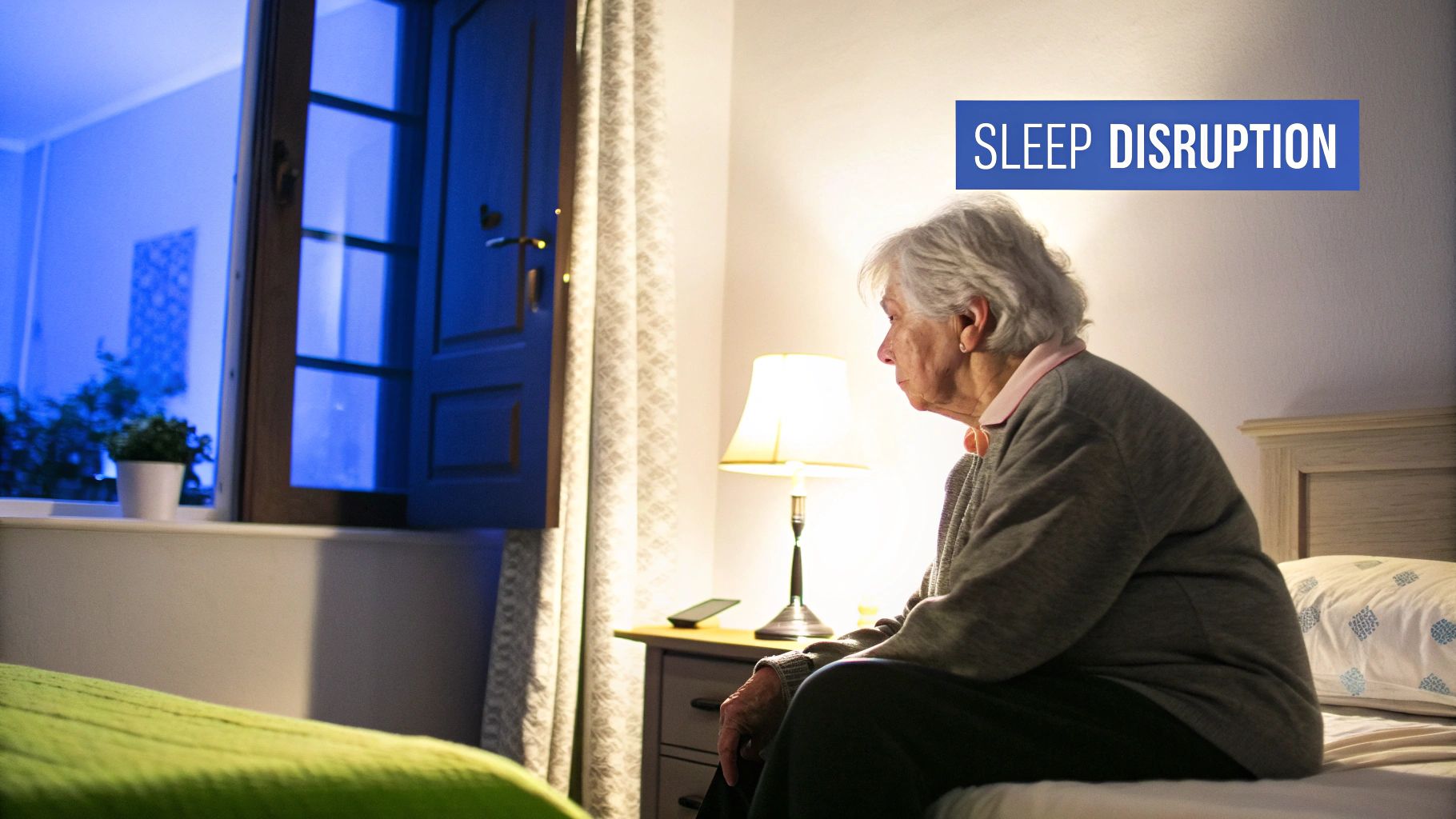
Think of your body’s internal sleep-wake cycle—the circadian rhythm—as a finely tuned clock. For most of your life, this clock keeps perfect time, signaling when it's time to feel alert and when it's time to wind down.
As we get older, however, the gears of this internal clock can become less precise. It might start to run a little fast, making you feel tired earlier in the evening and causing you to wake up well before you feel ready. This shift is natural, but when it leads to chronic sleep loss, it’s a problem that needs attention.
The Scope of Elderly Insomnia
This is far from an isolated issue affecting only a few people. In fact, insomnia is incredibly common among older adults, creating a significant public health concern. The numbers paint a clear picture of just how widespread these sleep disturbances are.
Research consistently shows that between 30% and 48% of older adults experience the symptoms of insomnia. One major study published in the Journal of Clinical Sleep Medicine found that roughly half of all adults over 65 report having a hard time either falling asleep or staying asleep.
Sleep is not a luxury, but a biological necessity. When insomnia takes hold in later life, it affects more than just energy levels; it impacts memory, mood, and overall physical health.
This disruption often shows up in a few common patterns. Pinpointing the specific type of sleeplessness can make it much easier to talk with a doctor and find a solution that works.
To help you identify these patterns, we’ve put together a simple table outlining the main ways insomnia appears in older adults.
Common Types of Insomnia Experienced by Older Adults
This table breaks down the primary ways insomnia manifests, helping you spot specific sleep issues.
| Type of Insomnia | Description | Common Example |
|---|---|---|
| Sleep-Onset Insomnia | Difficulty falling asleep at the beginning of the night, often taking more than 30 minutes. | Lying in bed for over an hour, feeling "wired" and unable to switch off your thoughts. |
| Sleep-Maintenance Insomnia | Waking up frequently during the night and struggling to get back to sleep. | Waking up at 2 AM and staying awake until 4 AM, feeling anxious or alert. |
| Early-Morning Awakening | Waking up much earlier than desired and being unable to fall back asleep. | Waking up at 4:30 AM every day, despite going to bed at 10 PM and feeling unrested. |
Recognizing these patterns is a powerful first step. It helps you understand exactly what’s happening and gives you the language to address the root cause of the issue and finally reclaim restful nights.
Uncovering the Causes of Sleepless Nights
Trying to figure out why a good night’s sleep becomes so hard to find for older adults can feel like solving a complex puzzle. It's rarely just one thing. More often than not, sleeplessness is a tangled web of the body's natural aging process, ongoing health issues, and even daily habits.
To make sense of it all, it helps to break down the potential causes into a few key areas. By looking at each one, you can start to pinpoint what might be getting in the way of a restful night for you or your loved one.
This diagram helps show how the big challenges of insomnia—trouble falling asleep, staying asleep, and feeling wiped out all day—are really just different sides of the same problem.
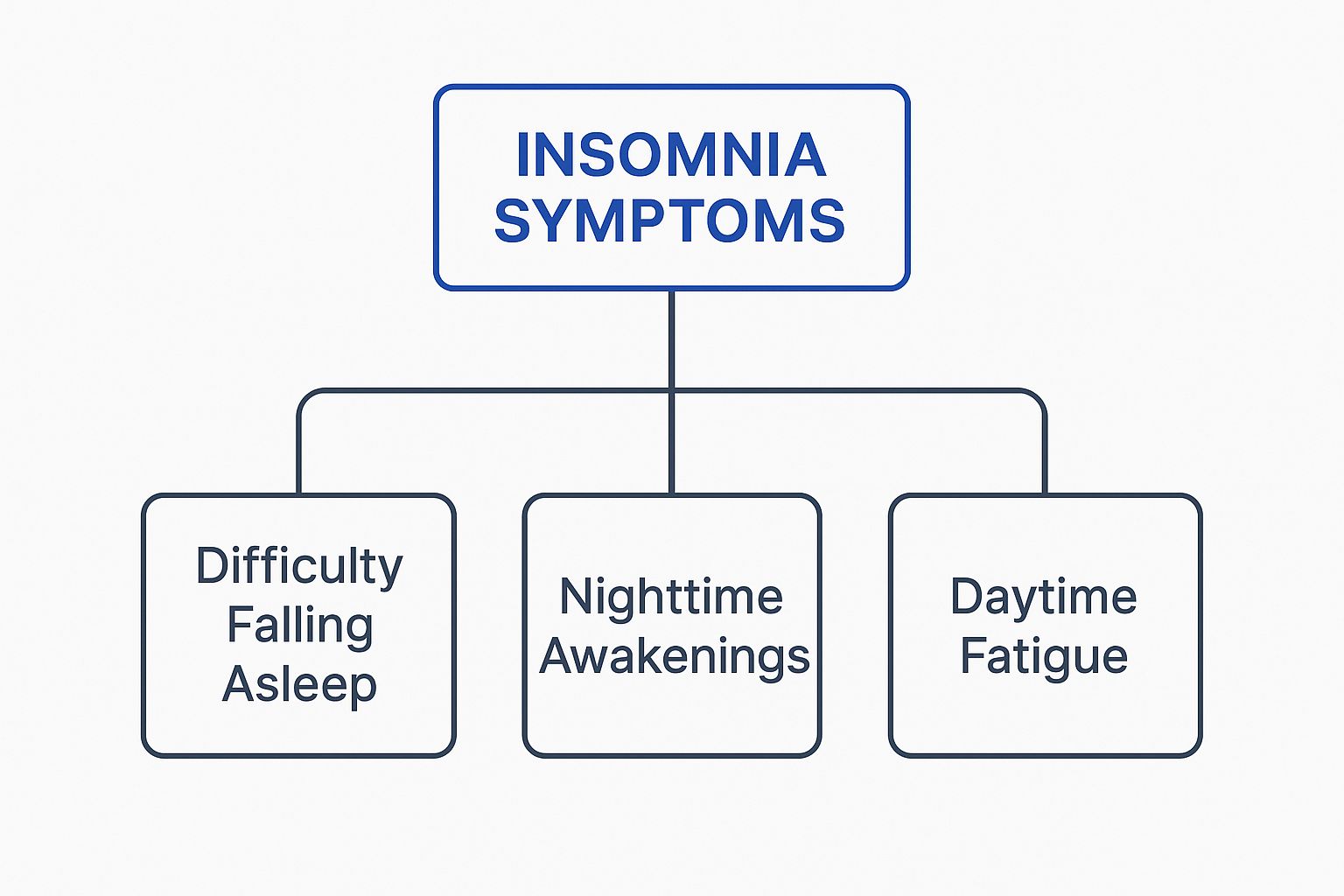
As you can see, insomnia isn't a single issue. It's a cluster of symptoms that can wreak havoc on both your nights and your days.
How Natural Aging Affects Sleep
As we get older, our internal "body clock," also known as our circadian rhythm, starts to change. Imagine the part of your brain that manages sleep—the suprachiasmatic nucleus—as an orchestra conductor. With age, that conductor’s timing can get a little less sharp.
This shift leads to some very real physiological changes that are often at the root of insomnia in an elderly person:
- Less Melatonin: The brain simply doesn't produce as much melatonin, the hormone that tells your body it's time to wind down. This makes it much harder to feel sleepy when bedtime rolls around.
- Lighter Sleep: Older adults spend far less time in the deep, restorative stages of sleep. The result is a lighter, more fragile sleep that's easily disturbed.
- An Earlier Body Clock: The internal clock often creeps forward. This is why many seniors feel tired early in the evening but then find themselves wide awake at 4 or 5 a.m., long before they've had enough rest.
While some changes to sleep patterns are expected, the chronic inability to get truly restorative sleep isn't just "getting older"—it's a sign that something deeper is going on.
The Role of Underlying Medical Conditions
Chronic health problems are a massive contributor to sleep issues in seniors. The pain, discomfort, and symptoms from these conditions don't just disappear when the lights go out. In fact, for many, they feel even worse.
Think about someone with arthritis. The joint pain they manage during the day can suddenly flare up at 3 a.m., making it impossible to get comfortable and fall back asleep. This kicks off a vicious cycle: the pain ruins their sleep, and the exhaustion from a sleepless night makes the pain feel even more intense the next day.
Poor sleep takes the challenges of a chronic illness and pours gasoline on the fire. When an older adult is already coping with a condition like heart failure or diabetes, adding sleepless nights can turn a manageable issue into a truly debilitating one.
Many common conditions are directly tied to elderly insomnia:
- Chronic Pain: Conditions like arthritis or neuropathy create a constant physical discomfort that wakes people up.
- Breathing Problems: Sleep apnea and COPD can cause dozens of awakenings throughout the night as breathing is interrupted.
- Heart Disease: Issues like heart failure can cause shortness of breath, especially when lying down.
- Neurological Conditions: Disorders like Parkinson's disease or Alzheimer's directly interfere with the brain's sleep-wake cycles.
- Nocturia: The medical term for frequent nighttime urination, often tied to diabetes or bladder problems, is a primary culprit for waking up repeatedly.
Daily Habits and Medication Side Effects
Beyond the body's internal changes, what we do every day—and what's in the medicine cabinet—plays a starring role. The side effects of common medications are a powerful, and often overlooked, cause of sleeplessness.
Many drugs prescribed for age-related conditions can directly disrupt sleep, even while they help manage other symptoms.
Common Culprits Include:
- Beta-Blockers: Prescribed for high blood pressure, these can unfortunately suppress melatonin production.
- Diuretics: These "water pills" are vital for managing fluid retention but also increase the need for nighttime bathroom trips.
- Corticosteroids: Great for reducing inflammation, but they can leave a person feeling agitated and "wired" at bedtime.
- Certain Antidepressants: While some have a sedating effect, others can be stimulating and interfere with deep sleep.
Finally, our daily routines can either set us up for success or for a night of tossing and turning. Things like erratic bedtimes, long naps in the afternoon, not getting enough sunlight, or having caffeine or alcohol too close to bedtime can throw the body's rhythm completely out of whack. This makes the already difficult job of getting a good night's sleep that much harder.
Of course. Here is the rewritten section, crafted to sound like an experienced human expert and match the provided examples.
Recognizing the Hidden Health Impacts of Insomnia
It’s all too easy to brush off insomnia as just feeling a bit tired the next day. But for an older adult, this view dangerously underestimates the real damage being done. A consistent lack of deep, restorative sleep acts like a slow-creeping problem, sending ripples through every part of their physical and mental well-being. The consequences go far beyond simple grogginess.
Think of sleep as the time when the body's dedicated maintenance crew finally gets to work. They repair tissues, file away memories, and keep hormones in check. When insomnia locks that crew out night after night, critical systems start to falter and break down. This isn't just a feeling; it's a cascade of very real health risks piling up in the background.
From Foggy Thinking to Serious Health Risks
One of the first and most obvious signs of poor sleep is what it does to cognitive function. When an older adult is constantly running on empty, their brain simply can't keep up. This often shows up as persistent fatigue, a short temper, and noticeable trouble with memory and concentration.
The connection between poor sleep and declining health is startling. Study after study confirms that insomnia in older adults significantly raises the risk for several serious issues:
- Increased Fall Risk: Daytime drowsiness and poor balance are a direct result of sleep deprivation, leading to devastating falls—a major cause of injury in seniors.
- Weakened Immune System: Chronic sleep loss hobbles the body's defenses, making it much harder to fight off infections and leaving older adults vulnerable to getting sick.
- Worsening Chronic Diseases: Insomnia can throw conditions like diabetes into chaos by messing with blood sugar regulation. It can also drive up blood pressure, putting extra strain on the heart.
This isn't a small-scale issue; it's a global health concern. Worldwide, an estimated 16.2% of adults struggle with insomnia, and about 7.9% have a severe case. As recent global health studies30161-X/fulltext) show, that's hundreds of millions of people whose health and quality of life are being quietly eroded by a lack of sleep.
Misdiagnosing the Problem: A Common Pitfall
Let’s look at a common scenario. George, an 80-year-old man, starts showing signs of confusion. He’s forgetting appointments, gets agitated easily, and often seems disoriented. His family, worried about dementia, rushes to schedule a neurological evaluation.
During the appointment, a deeper conversation reveals something crucial: George hasn't had a full night's sleep in months. He wakes up every couple of hours, his mind racing. The doctor begins to suspect the real problem isn't dementia, but severe, untreated insomnia in elderly adults.
After starting a plan to improve his sleep, George's "cognitive symptoms" almost completely disappeared within a few weeks. He wasn't losing his mind; his brain was simply starved for rest and exhausted to the point of dysfunction.
George's story highlights a critical point. The symptoms of severe sleep deprivation in an older person can look almost identical to early-stage dementia or other serious neurological conditions. Families and even some healthcare providers can misread the signs, leading to a lot of unnecessary stress and the wrong diagnosis.
Often, tackling the sleep problem first is the key to unlocking a dramatic improvement in health. It doesn't just bring back energy—it restores mental clarity, emotional balance, and physical safety. Recognizing the true, far-reaching impact of insomnia is the first and most important step toward finding a solution and protecting an older adult’s quality of life.
Powerful Drug-Free Treatments and Strategies
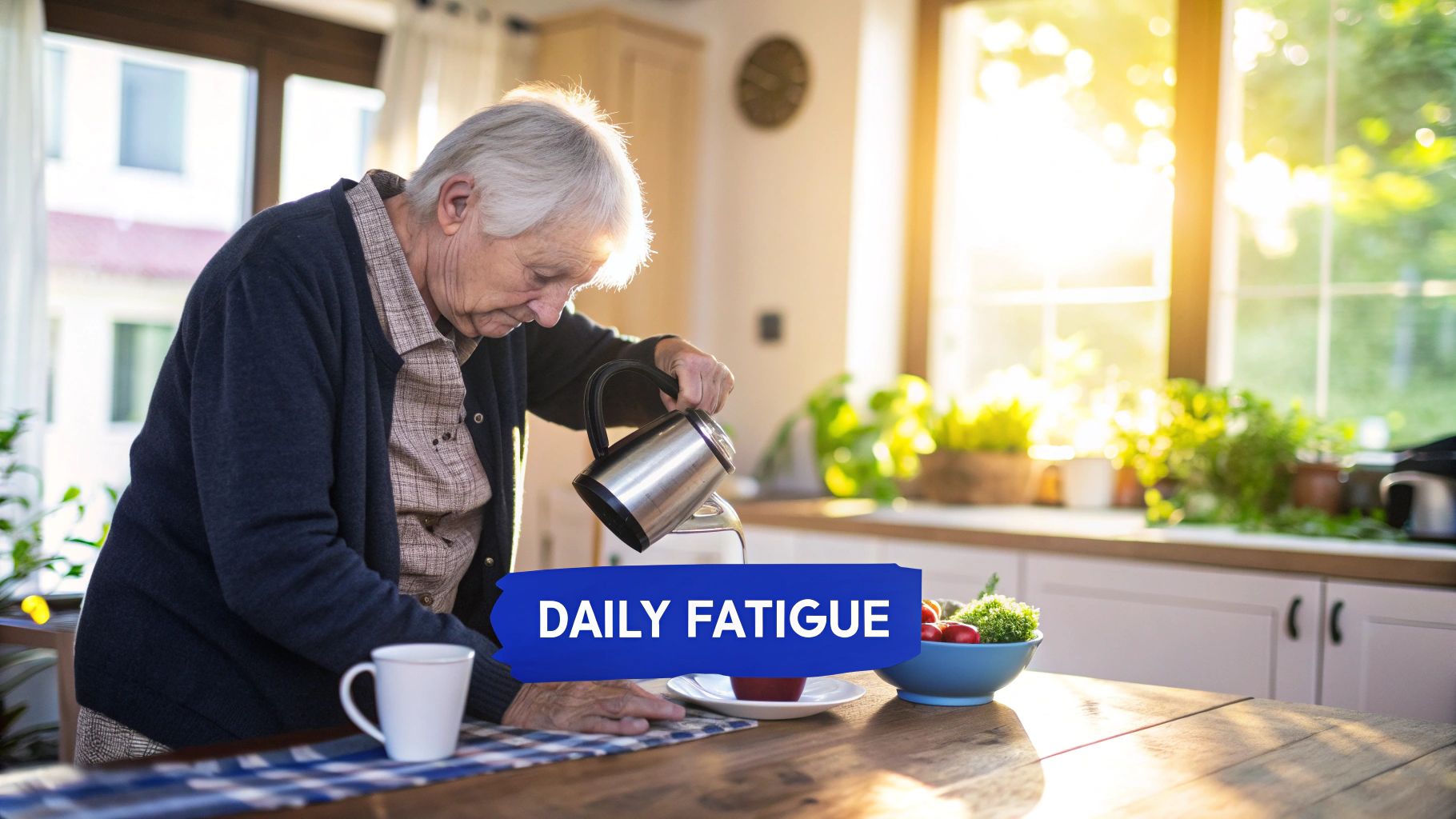
While reaching for a pill might feel like a quick fix for sleepless nights, the most powerful and lasting solutions often don’t come from a pharmacy. When it comes to insomnia in elderly adults, sleep experts overwhelmingly recommend a non-drug approach as the first line of defense: Cognitive Behavioral Therapy for Insomnia (CBT-I).
Think of CBT-I as a personal retraining program for your brain and body. It's designed to reset your natural sleep-wake rhythm from the ground up. Instead of just masking the symptoms with medication, this therapy gives you the tools and skills to foster healthy sleep for the long haul by tackling the real sources of the problem—the thoughts and behaviors that are keeping you awake.
Unpacking Cognitive Behavioral Therapy for Insomnia
CBT-I isn't just one magic trick; it’s a toolkit of practical strategies that work in harmony to rebuild healthy sleep patterns. Its main job is to break that frustrating cycle where worrying about not sleeping becomes the very thing that keeps you from sleeping.
The ultimate goal is to get your brain to once again see your bed as a sanctuary for rest, not a place for stress. Let's look at the key pillars that make this approach so effective.
Stimulus Control Therapy
This technique is all about re-forging the mental connection between your bedroom and actual sleep. If you've spent countless hours tossing and turning, your brain has likely started to associate your bed with frustration and wakefulness. Stimulus control helps undo that damage.
Here's how it works:
- Go to bed only when you're genuinely sleepy. This means feeling that heavy-eyed drowsiness, not just heading to bed because the clock says it's time.
- Reserve your bed for only two things: sleep and intimacy. That means no more watching TV, working on a laptop, or worrying in bed.
- If you can't fall asleep within about 20-30 minutes, get up. Go to another room and do something quiet and relaxing—like reading in dim light—until you feel sleepy again. Then, head back to bed.
- Stick to a consistent wake-up time every single day. This is a non-negotiable, even after a rough night or on the weekend.
Following these steps retrains your brain to expect sleep the moment your head hits the pillow, making it much easier to drift off naturally.
Sleep Restriction Therapy
This might sound backward, but temporarily limiting your time in bed can work wonders for your sleep quality. This method boosts what sleep specialists call sleep efficiency—the percentage of time you’re actually asleep while in bed.
Think of your sleep as a weak, watered-down drink. Sleep restriction therapy gets rid of the extra water, making what’s left more concentrated and potent. By spending less time awake in bed, you build a much stronger biological drive for sleep, which leads to deeper, more consolidated rest. A therapist will help you figure out the right "sleep window" for you and then gradually expand it as your sleep improves.
The core principle of CBT-I is that you can actively reshape your sleep habits. It’s about teaching your body and mind how to sleep well again, providing a lasting solution that medications can't offer.
Building a Foundation with Better Sleep Hygiene
Sleep hygiene is all about the daily habits and environmental tweaks that set you up for a successful night. While it might not be enough to cure chronic insomnia on its own, good sleep hygiene is a critical piece of the puzzle for any successful treatment plan.
To get started, it helps to have a clear roadmap. This simple checklist can help you optimize your routine and bedroom for better sleep.
Sleep Hygiene Checklist for a Better Night's Rest
| Category | Action Item | Why It Helps |
|---|---|---|
| Environment | Keep the bedroom dark, cool, and quiet. | These conditions signal to your brain that it's time to produce melatonin and wind down for sleep. |
| Routine | Establish a relaxing pre-sleep ritual. | Activities like a warm bath, gentle stretching, or reading can cue your body that sleep is approaching. |
| Diet | Avoid large meals, caffeine, and alcohol before bed. | Stimulants and heavy foods can disrupt sleep architecture and cause awakenings. A light, carb-based snack is okay. |
| Lifestyle | Get daily exposure to natural light, especially in the morning. | Sunlight helps anchor your internal body clock (circadian rhythm), promoting daytime alertness and nighttime sleepiness. |
Following these guidelines consistently creates the perfect stage for restorative sleep to happen naturally.
The Power of Gentle Movement and Mindfulness
Making gentle daily activity a part of your routine is another fantastic tool for combating insomnia in older adults. You don’t need to run a marathon; in fact, calming exercises are often even better for promoting sleep.
Activities like tai chi, gentle yoga, or even just a brisk daily walk have been shown to reduce stress, lift your mood, and help you sleep more soundly. The trick is consistency and timing—try to get your activity in earlier in the day, since exercising too close to bedtime can be a bit too energizing for some. These practices don't just help your body; they help quiet the racing thoughts that so often fuel a sleepless night.
When lifestyle tweaks and drug-free approaches just aren't cutting it, it might be time to bring in a medical professional. This step isn't just about getting a prescription. It's about playing detective to make sure another health problem isn't the real culprit behind those sleepless nights.
A full medical work-up is so important. What looks like simple insomnia in elderly adults can sometimes be a symptom of something else entirely. A doctor can help pinpoint or rule out conditions like Restless Legs Syndrome (RLS), sleep apnea, or even side effects from other medications that are messing with sleep.
Navigating Medical and Professional Sleep Aids
For stubborn, persistent insomnia, a doctor might suggest a prescription sleep aid. These can be a real lifesaver in the short term, breaking that miserable cycle of sleeplessness and helping to reset your internal clock. But they aren't a magic bullet, especially for older adults.
As we age, our bodies process medications differently, which can make seniors more sensitive to side effects. It’s why physicians are always extra cautious when prescribing sleep medications for their older patients.
Think of prescription sleep medication as a temporary bridge to better sleep, not a permanent destination. The goal is always to use the smallest dose that works for the shortest time possible, all under a doctor's watchful eye.
It's a balancing act. The potential risks for older adults are significant and have to be carefully weighed against the benefits. These risks can include:
- Next-Day Drowsiness: A lingering "hangover" feeling that can fog up thinking and make coordination tricky long after waking.
- Increased Fall Risk: Dizziness and poor balance are common side effects, which dramatically increases the danger of a serious fall.
- Cognitive Side Effects: Some medications can unfortunately lead to memory issues or confusion.
- Dependency: Using these aids for too long can lead to the body and mind relying on them to get to sleep.
That's why the decision to use a prescription aid has to be a team effort between the patient, their family, and their doctor.
What About Over-the-Counter Aids and Supplements?
Walk down any pharmacy aisle, and you'll see shelves full of over-the-counter (OTC) sleep aids and supplements. Melatonin is probably the most popular one. But even though these options are easy to get, "natural" doesn't automatically mean "safe," particularly for seniors.
Melatonin is a hormone your own body makes to manage its sleep-wake cycle. As a supplement, it can offer some help, especially for things like jet lag. For chronic insomnia in the elderly, however, the evidence is a bit shaky. Plus, the supplement industry isn't heavily regulated, meaning the dose and purity can be a real grab bag from one bottle to the next.
Other OTC sleep aids, often the ones with antihistamines like diphenhydramine (the stuff in Benadryl), come with their own list of warnings. They’ll make you drowsy, sure, but they can also cause a host of side effects in older adults, like confusion, dry mouth, blurred vision, and problems with urination.
Before you even think about trying an OTC product, it's absolutely essential to talk it over with a doctor or pharmacist. They can spot potential conflicts with your other medications and help you figure out if it's a safe choice for you. When it comes down to it, medical treatments are a valuable tool in the toolbox, but they need to be handled with professional guidance to bring back those restful nights safely.
A Global View on Senior Sleep Challenges
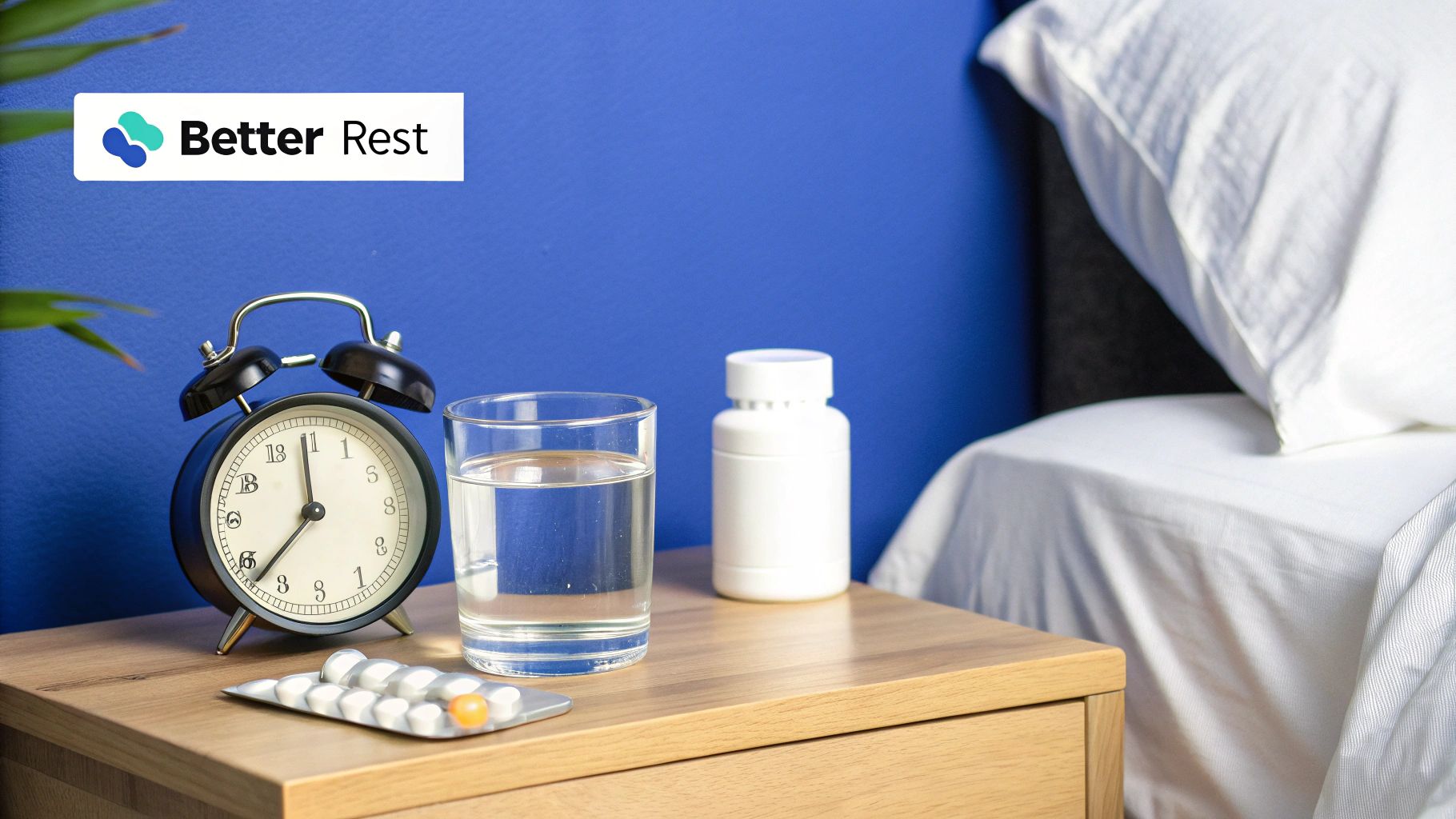
If an older adult in your life is struggling with sleepless nights, it’s easy to feel isolated. But the truth is, this challenge is anything but unique. It's a shared human experience that crosses every border, recognized by health experts worldwide as a major public health concern.
While insomnia in elderly populations is a common thread, how it shows up—and how often it’s talked about—can look very different from one country to the next. Looking at it from this global perspective helps show that millions are navigating the same frustrations. It's a real medical issue with real solutions, not a personal failing or something to be quietly endured.
Prevalence Rates Around the World
When you look at the research, the numbers on insomnia can seem to be all over the map. These differences often come down to cultural norms around discussing health, how doctors define sleep problems, or even the methods used in a particular study.
Still, the big picture is crystal clear: a huge number of seniors everywhere are dealing with this.
For example, studies across Asia show a massive range, with anywhere from 6% to 41% of Chinese seniors reporting insomnia. In the Middle East, the numbers climb even higher. Research from Egypt points to rates around 50%, while a clinic-based study in Iran found a staggering 62.1% prevalence. A 2018 study in Pakistan wasn't far behind, highlighting a 42.1% rate among its older population. You can dive deeper into these regional differences by reviewing the global insomnia research findings.
A powerful insight emerges from all this data, no matter where you look: women consistently report higher rates of insomnia than men. In that Pakistani study, for instance, 64.1% of those struggling with insomnia were women.
Normalizing the Conversation
Understanding this global context is so important. It confirms that if you or a loved one is tossing and turning all night, you are far from alone. This isn't just a local problem; it's a worldwide health priority.
Realizing that this is a shared experience can be incredibly empowering, helping to move past feelings of isolation and take that first step toward getting help.
When older adults and their families see that insomnia is a recognized and, most importantly, treatable condition, it builds the confidence needed to seek professional support. The journey to a restful night begins with knowing that solutions are out there and that you're part of a global community all working toward better sleep.
Common Questions About Insomnia in Older Adults
When you’re dealing with sleepless nights, especially later in life, a lot of questions come up. For older adults and the family members caring for them, getting straight, practical answers can make all the difference. Let’s tackle some of the most common concerns we hear about managing insomnia in the elderly.
Should Seniors Nap During the Day?
This is a classic dilemma. A quick nap can feel like a godsend, but if you’re not careful, it can steal from your sleep later that night. It helps to think of your daily sleep as a total budget—if you use too much of it during the day, you'll come up short when it’s time for bed.
For most older adults, the sweet spot is a short nap of no more than 30 minutes, and it's best to take it before 3 PM. This can give you a nice little energy boost without messing with your body’s natural drive to sleep in the evening. If you find that daytime drowsiness is just too much to handle, it's often a big red flag that your nighttime sleep quality needs attention.
Are Sleeping Pills a Good Idea?
The promise of a quick fix from a sleeping pill is incredibly tempting, but for older adults, it’s a path filled with risks. Seniors are much more sensitive to side effects like feeling groggy the next day, dizziness, and confusion. These issues can dramatically increase the risk of a dangerous fall.
While medication might offer some relief in the short term, it's not a real long-term fix. The gold standard—and the first thing experts recommend—is a drug-free approach called Cognitive Behavioral Therapy for Insomnia (CBT-I). It essentially retrains your brain and body for healthy, natural sleep.
If medication seems absolutely necessary, it should only be used under a doctor's close watch, at the lowest dose possible, and for the shortest amount of time.
Can Diet and Exercise Really Help?
They absolutely can. What you eat and how much you move have a direct line to your sleep quality. Building gentle, regular physical activity into your day—think a daily walk, some tai chi, or light stretching—has been proven to help people sleep more deeply and for longer. The trick is consistency and timing; you’ll want to avoid any intense exercise within three hours of your bedtime.
Your eating habits are just as important. A few simple tweaks can make a huge difference:
- Avoid big meals and caffeine in the late afternoon and evening.
- Limit alcohol. While it might make you feel drowsy at first, it often disrupts sleep later in the night.
- Try a light snack before bed that's high in carbohydrates, like a small bowl of oatmeal or a piece of toast. It can actually help signal to your brain that it's time to rest.
Making these small, consistent changes can build a powerful foundation for more restful nights and, ultimately, better health.
Trying to manage sleep and the other daily challenges of caring for an aging loved one can feel completely overwhelming. NJ Caregiving is here to help. We provide compassionate, professional in-home support to help seniors in Princeton, NJ, and the surrounding Mercer County area live safely and comfortably right where they want to be. Our dedicated caregivers can assist with creating calming bedtime routines, managing medications, and making sure the home environment is secure. If you need support, learn how our personalized care plans can bring peace of mind to your family.

